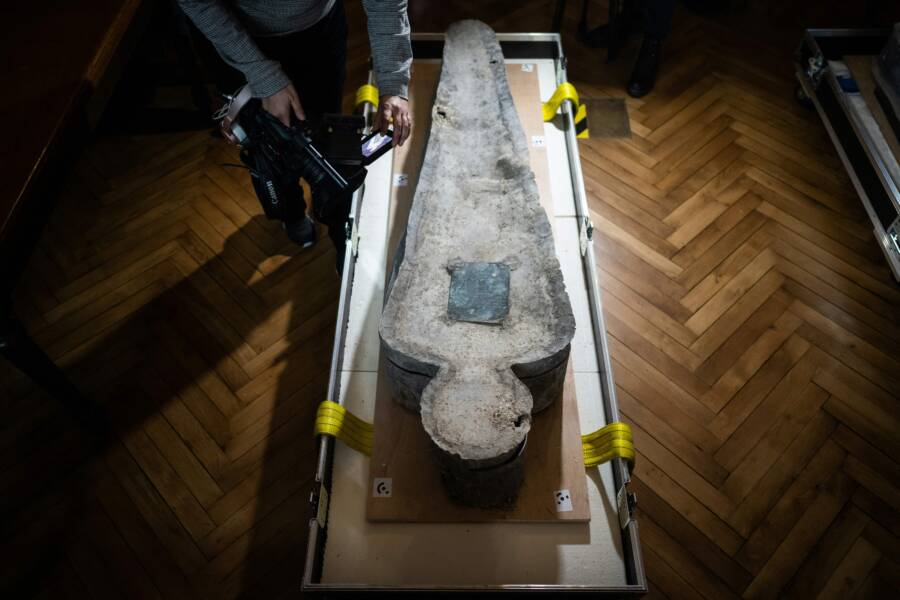The sarcophagi found under Notre Dame come from different eras, and the older of the two contains the remains of a man with an oddly deformed skull.

LIONEL BONAVENTURE/AFP via Getty ImagesOne of the two sarcophagi discovered beneath Notre Dame in Paris.
In 2019, people across the world watched in horror as fire consumed the 850-year-old Notre Dame Cathedral in Paris. But the tragedy has produced unexpected archaeological delights.
While preparing for the site’s restoration, experts came across two ancient sarcophagi — and one set of the remains has them scratching their heads.
According to a press statement released by the Université Toulouse III – Paul Sabatier, the two sets of remains were examined by archaeologists with the National Institute of Preventive Archaeological Research (INRAP). The older of the two coffins appeared to contain a knight — his pelvic bones suggested he was an experienced horseman — who had a strangely elongated head.
As The Guardian notes, this deformity may have been intentional. The knight probably wore a headdress or headband as an infant, which shaped his skull.

LIONEL BONAVENTURE/AFP via Getty ImagesThe two sarcophagi found in Notre Dame displayed side by side.
However his life began, archaeologists suspect that he suffered a gruesome end. Just around 30 years old when he died, the man nicknamed “Le Cavalier” or “the Knight” appeared to have struggled with a chronic disease. Eric Crubézy, professor of biological anthropology at the University of Toulouse III, noted that he had lost all of his teeth by the time he died.
“He would have had a difficult end of life,” Crubézy told The Guardian.
For now, little else is known about Le Cavalier, may have been a nobleman who lived as long ago as the 14th century. Researchers explained that they might be able to learn more, but only if details about his life and death were recorded somewhere.
“If the date of his death was around the second half of the 16th century or early 17th century, we may be able to identify him in the death register that we have,” Christophe Besnier, an anthropologist with INRAP, told The Guardian. “If it’s earlier than that, we probably won’t ever know who he was.”
But while little is known about Le Cavalier’s identity — the University of Toulouse III called him an “illustrious stranger” — a bit more is understood about the man in the other sarcophagus. Archaeologists even known his name, as it’s engraved on the top of his tomb.
“THIS IS THE BODY OF MESSIRE ANTOINE OF THE CANON PORTE OF THE CHURCH [word erased] DEATH DECEMBER 24, 1710 IN HIS 83RD YEAR. REQUIESCAT IN PEACE,” the engraving on de la Porte’s sarcophagus reads, according to the press release.

LIONEL BONAVENTURE/AFP via Getty ImagesThe engraving on Antoine de la Porte’s sarcophagus clearly identifies him.
De la Porte was once the canon of Notre Dame Cathedral. He gave money to help renovate the enclosure of the cathedral’s choir and commissioned numerous paintings which today hang in the Louvre.
Unlike Le Cavalier, researchers noted that de la Porte had very good teeth.
“They were remarkable for his age,” Crubézy told The Guardian. “We see this very rarely, but he clearly cleaned his teeth and took care of them.”
Indeed, despite their place of burial, researchers noted that the two tombs found beneath Notre Dame are quite dissimilar.
“The two coffins are very different,” the University of Toulouse III explained. “[T]hey have neither the same form, nor the same method of assembly, nor the same alloy, nor the same age (they belonged to distinct archaeological layers).”
For now, the study of the two sets of remains will continue. Archaeologists expect that they’ll release further findings in the first half of 2023.
The remains, noted INRAP president Dominique Garcia, were not merely “archaeological objects.” He told The Guardian that they would be treated “with respect from beginning to end.”
Once researchers have completed their study, the two sarcophagi will be turned over to France’s Ministry of Culture. Meanwhile, the renovations of Notre Dame are expected to be complete by 2024.
After reading about the strange remains found beneath Paris’s Notre Dame Cathedral, look through these tragic photos of the fire that nearly destroyed Notre Dame in 2019. Or, delve into the haunting story of the Paris catacombs.





